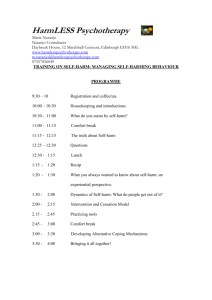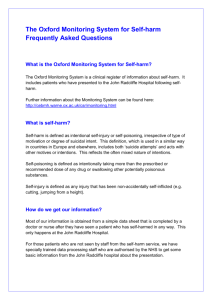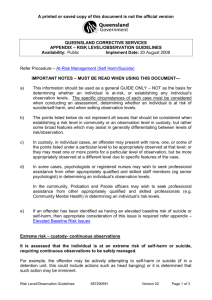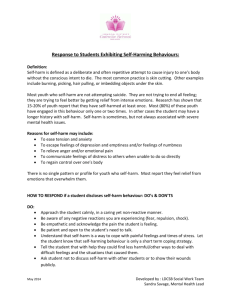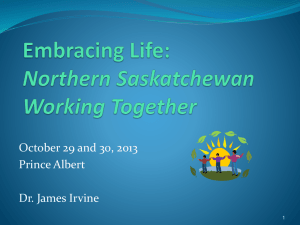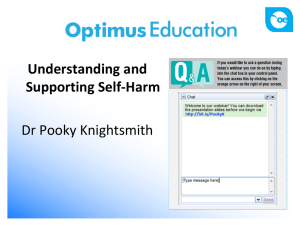Review and recommendations of the Council`s
advertisement
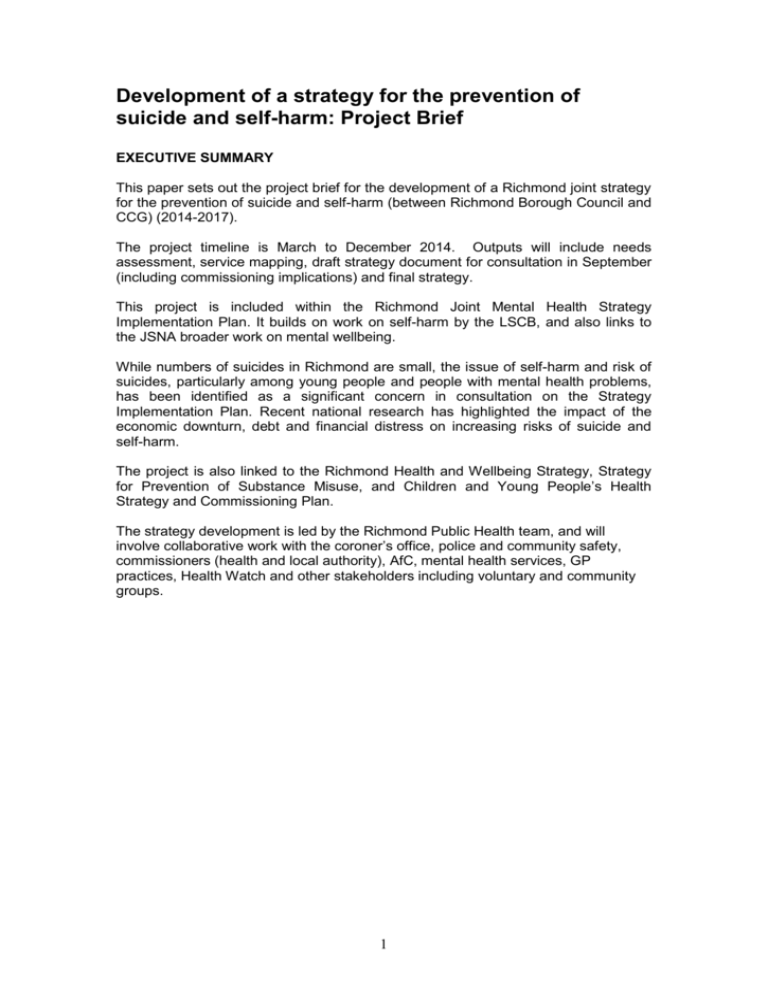
Development of a strategy for the prevention of suicide and self-harm: Project Brief EXECUTIVE SUMMARY This paper sets out the project brief for the development of a Richmond joint strategy for the prevention of suicide and self-harm (between Richmond Borough Council and CCG) (2014-2017). The project timeline is March to December 2014. Outputs will include needs assessment, service mapping, draft strategy document for consultation in September (including commissioning implications) and final strategy. This project is included within the Richmond Joint Mental Health Strategy Implementation Plan. It builds on work on self-harm by the LSCB, and also links to the JSNA broader work on mental wellbeing. While numbers of suicides in Richmond are small, the issue of self-harm and risk of suicides, particularly among young people and people with mental health problems, has been identified as a significant concern in consultation on the Strategy Implementation Plan. Recent national research has highlighted the impact of the economic downturn, debt and financial distress on increasing risks of suicide and self-harm. The project is also linked to the Richmond Health and Wellbeing Strategy, Strategy for Prevention of Substance Misuse, and Children and Young People’s Health Strategy and Commissioning Plan. The strategy development is led by the Richmond Public Health team, and will involve collaborative work with the coroner’s office, police and community safety, commissioners (health and local authority), AfC, mental health services, GP practices, Health Watch and other stakeholders including voluntary and community groups. 1 PROJECT BRIEF 1 Definitions of suicide and self-harm In the UK, suicide is defined as deaths given an underlying cause of intentional selfharm or injury/poisoning of undetermined intent. Self- harm is defined by NICE as “any act of self-poisoning or self-injury carried out by a person, irrespective of their motivation.” Self-harm is a significant risk factor for suicide: there is a 50- to 100-fold increased risk of death by suicide in the twelve month period after an episode of self-harm compared to the general population. A wide range of mental health problems are associated with self-harm, including borderline personality disorder, depression, bipolar disorder, schizophrenia, and drug and alcohol-use disorders. This project will cover both adults and young people1. Services have an important role in helping families, parents, teachers and others deal with both the threat and consequences of self-harm and suicide. 2 Scale of suicide and self-harm Suicide and self-harm are not inevitable, and there is substantial evidence-based guidance on how the risks of suicide and self-harm can be reduced as the basis for prevention strategies. In Richmond the number of suicides in a year are small–ranging from 7 to 19 individuals annually 2008 to 2012. Richmond had an age standardised mortality rate for suicide and undetermined injury for 2010/12 of 8.3 per 100,000. This is not significantly different to the figure for England of 8.5 per 100,000. Rates of hospital admission for self-harm in 2011/12 were significantly lower in Richmond compared to England- at 109 per 100,000 and 207 per 100,000 respectively. The rates for London were 112 per 100,000. Clearly there are a proportion of cases that are not admitted to hospital. 3 The strategic context The development of this suicide and self-harm prevention strategy is a project within the Richmond Joint Mental Health Strategy Implementation Plan. Suicide and self-harm indicators are included in the National Public Health Outcomes Framework. The Government published in 2012 a new national cross-government strategy for suicide prevention (Preventing Suicide in England: 2012). This strategy sets out six goals: 1 Suicides in those aged 15 years and over in Richmond, and episodes of self-harm among people aged 8 years and over. This is in keeping with national definitions and data availability. 2 1. 2. 3. 4. To reduce the risk of suicide in key high-risk groups Tailor approaches to improve mental health in specific groups Reduce access to the means of suicide Provide better information and support to those bereaved or affected by suicide 5. Support the media in delivering sensitive approaches to suicide and suicidal behaviour 6. Support research, data collection and monitoring The recent national strategy update (January 2014) reports that around half of people who die by suicide have a history of self-harm. It stresses the importance of mental health promotion, prevention and early intervention to reduce self-harm in the community, and of effective assessment and on-going management when an individual who has self-harmed presents to health services. The new NICE Quality Standard for self-harm (2013) is intended to inform the planning and delivery of services for those who self-harm. It focuses on treatment with compassion and respect, the importance of comprehensive assessment, monitoring and risk reduction in the clinical environment. There is also a focus on continuing support with a risk management plan and psychological interventions to reduce recurrence. 4 Project aims To assess the pattern of suicide and self-harm in Richmond To map services currently available and options to intervene To produce a joint strategy for Richmond 2014-2017 as a framework for a coordinated and effective approach to improved services for the prevention of suicide and self-harm. To define implications for commissioning and service development 2015/16. 5 Objectives To conduct a needs assessment for suicide and self-harm (including audit work) to determine the pattern of suicide and self-harm and related risk factors, (and including equality considerations) To identify and engage key local stakeholders with a responsibility or interest in self-harm and suicide To review and identify the evidence for effective strategies/practice to reduce the rates of suicide and support the needs of those who have selfharmed To identify and map current services concerned with the prevention of suicide and support those who have self-harmed in terms of medical, psychological and social needs To identify and map current services which support those who are made bereft by the suicide of a partner, friend or relative To identify key priorities for Richmond and make recommendations for a multi-agency approach to prevention of suicide and self-harm To ensure performance management arrangements are in place to enable monitoring of the impact of the strategy over time. 6 Project Plan The analysis of patterns of suicide and self-harm will be based on both quantitative and qualitative data and information, including engagement with service users and families. 3 The needs analysis will provide an overview on the current situation in Richmond: available data will help benchmark the borough against wider trends and factors which correlate with higher rates of suicide and self-harm. The potential use of data (Mental Health Trust, Coroner, GP data, A&E) for audit work of cases will be examined in order to understand more fully the circumstances and factors causing suicide and self-harm. The analysis will identify high risk groups as the focus for prevention measures. The potential use of risk stratification for self-harm and the effectiveness of different approaches to subsequent management will be examined. The mapping of local services relevant to prevention of suicide and management and prevention of self-harm against an evidence-based framework will identify gaps and options for service development and quality improvement. A multi-agency stakeholder workshop will be organised to consider the findings of the needs analysis and service mapping work. A draft strategy will be produced taking account of the workshop discussion with proposed actions informing commissioning intentions. 7 Management and Governance The project will report to the Joint Adult Mental Health Strategy Group, and Strategic Partnership Group (and Health and Wellbeing Board) and Community Safety Partnership Public health team: Principal and Ben Bouquet (Specialist Registrar), Amanda Killoran (PH Key stakeholders: Coroner’s office Mental health services Substance misuse services Social services Commissioners GPs Secondary care clinicians involved in the self-harm pathway Children’s services Health Watch Local interest groups – specifically suicide/self-harm campaign; patient groups; relatives Local interest groups – high-risk categories e.g. LBGT, BME, men’s health 8 Summary Timetable Phase 1: March-May 2014 Needs assessment and service mapping (including equality impact audit) Phase 2: March-May 2014 Suicide and self-harm audit Phase 3: April-June 2014 Review evidence for effective interventions & mapping current services Phase 4: July-December 2014 Draft suicide and self-harm prevention strategy including commissioning implications (September) and consultation; final strategy 4 5
